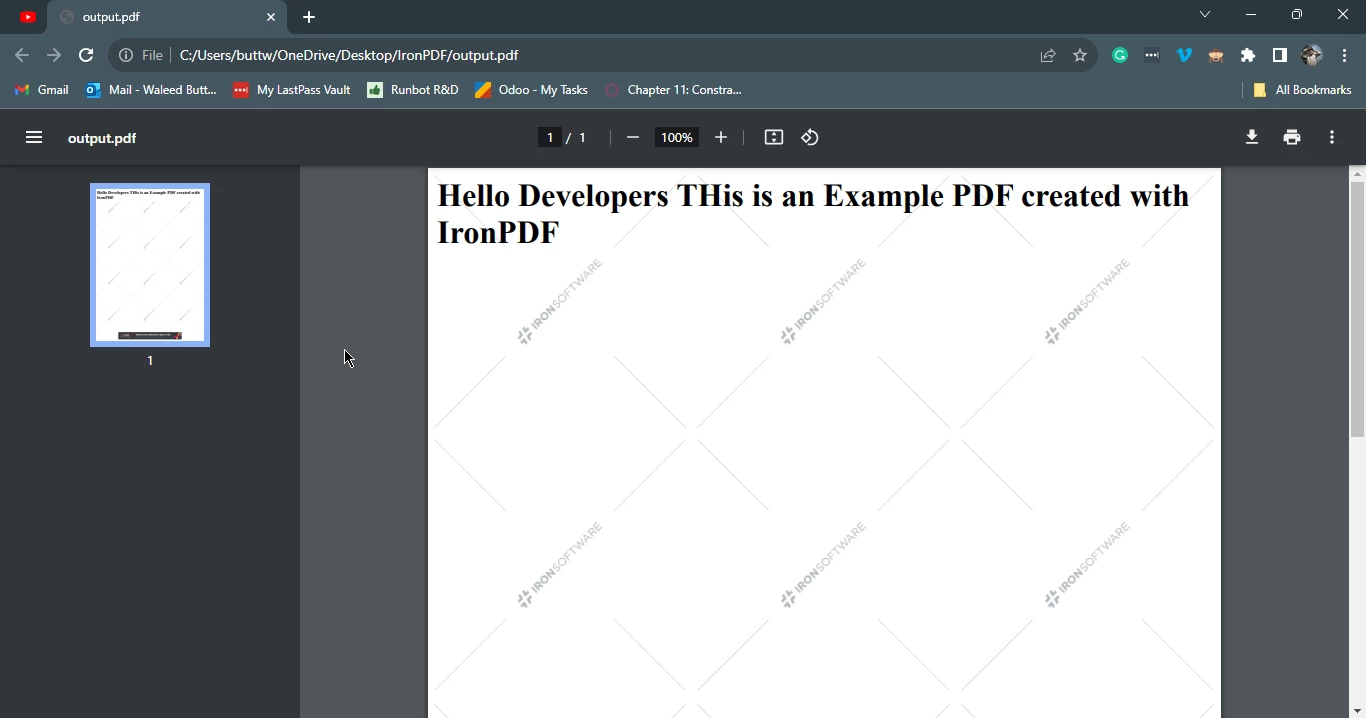Test in a live environment
Test in production without watermarks.
Works wherever you need it to.
In the dynamic and ever-progressing realm of web development, the demand for converting HTML to PDF emerges with remarkable frequency. This necessity spans a spectrum of applications, ranging from the creation of detailed reports and invoices to the essential task of preserving web content in a readily printable format. The seamless conversion of HTML pages to PDF within a Node.js environment stands as a pivotal requirement for developers navigating the intricacies of modern web applications.
In this article we will discuss HTML to PDF Node.js Without Puppeteer. However, Puppeteer runs headless, headless browser and within this landscape of possibilities, developers now have access to a diverse array of alternative libraries. Among these, the IronPDF for Node.js library emerges as a standout option—an exceptionally potent tool designed explicitly for executing PDF-related operations within the Node.js (JavaScript) ecosystem.
PdfDocument.fromUrl method.PdfDocument.fromHtml method.saveAs method.IronPDF is a versatile Node.js PDF library that provides a robust set of features for working with PDF files. One of its key functionalities is the ability to convert HTML to PDF format without the need for Puppeteer. This makes IronPDF an attractive solution for developers looking for a lightweight and efficient way to handle HTML to PDF conversion in their Node.js applications. IronPDF also supports the conversion of CSS versions and headers. IronPDF allows you to generate PDFs from Images that work seamlessly in a production environment.
Getting started with IronPDF is a straightforward process. To install IronPDF in your Node.js project, you can use NPM, the package manager for Node library. Open your terminal and run the following command:
npm i @ironsoftware/ironpdf
This command will download and install the IronPDF library, making it available for use in your project. To install the IronPDF engine that is required for using IronPDF Library, run the following command on the console:
npm install @ironsoftware/ironpdf-engine-windows-x64
Now that IronPDF is downloaded and installed, let's explore how to use it for HTML to PDF conversion. We'll walk through three common scenarios: converting a URL to PDF, converting an HTML string to PDF, and converting an HTML file to PDF.
Converting a web page to a PDF is a frequent requirement, especially when dealing with dynamic content generated by a server. IronPDF makes this process simple. Here's a basic code example:
import { PdfDocument } from "@ironsoftware/ironpdf";
(async () => {
// URL of the web page to convert to PDF
const url = "https://google.com";
// Create a PDF document from the specified URL
const pdf = await PdfDocument.fromUrl(url);
// Save the PDF to a file
await pdf.saveAs("output_from_url.pdf");
})();This code uses the IronPDF library to convert a web page (Wikipedia's PDF page) into a PDF file. It sets the page provided URL, helps generate PDF with PdfDocument.fromUrl() method, and saves it as "output_from_url.pdf". The entire process is wrapped in an asynchronous function, ensuring sequential execution. This snippet showcases the simplicity of leveraging IronPDF for HTML to PDF conversions in Node.js. For output refer to the below screenshot.

If you have HTML content as a string and need to convert it to a PDF, IronPDF provides a convenient method for this scenario as well:
import {PdfDocument} from "@ironsoftware/ironpdf";
(async () => {
// Create a PDF from an HTML string
const pdf = await PdfDocument.fromHtml("<h1>Hello Developers THis is an Example PDF created with IronPDF</h1>");
// Export the PDF to a file
await pdf.saveAs("output.pdf");
})();This code example uses the IronPDF library to quickly convert a simple HTML string (a heading tag) into a PDF document. It then saves the generated PDF as "output.pdf." The script is concise, employing an asynchronous function for sequential execution. This showcases the simplicity of creating PDFs from HTML using IronPDF in a Node.js environment.

For situations where the HTML content is stored in a file, IronPDF provides a straightforward method to convert it to a PDF. Here's an example:
import {PdfDocument} from "@ironsoftware/ironpdf";
(async () => {
// Render the HTML file
const pdf = await PdfDocument.fromHtml("label.html");
// Export the PDF document
await pdf.saveAs("output.pdf");
})();This code snippet utilizes the IronPDF library to convert the content of an HTML file ("label.html") into a PDF document. The rendered PDF is then saved as "output.pdf." The simplicity of this process is highlighted by the concise script, which employs an asynchronous function for sequential execution in a Node.js environment.

In this guide, we've explored the process of converting HTML to PDF in a Node.js environment without relying on Puppeteer. IronPDF proves to be a powerful and efficient alternative, offering a range of features for handling PDF-related tasks. Whether you need to convert a URL, an HTML string, or an HTML file to PDF or generate a PDF file from PNG images, IronPDF provides a seamless solution.
As you integrate HTML to PDF conversion into your Node.js applications, consider the specific requirements of your project and the flexibility that IronPDF offers. With its ease of use and extensive capabilities, IronPDF stands out as a valuable tool for developers seeking a reliable and lightweight solution for PDF generation in Node.js.
To know more about IronPDF for Node.js, please visit the documentation page. The complete tutorial of HTML to PDF conversion using IronPDF for Node.js is available at the following link.
IronPDF offers a free trial license for users to get started, before deciding to purchase a perpetual license.
9 .NET API products for your office documents